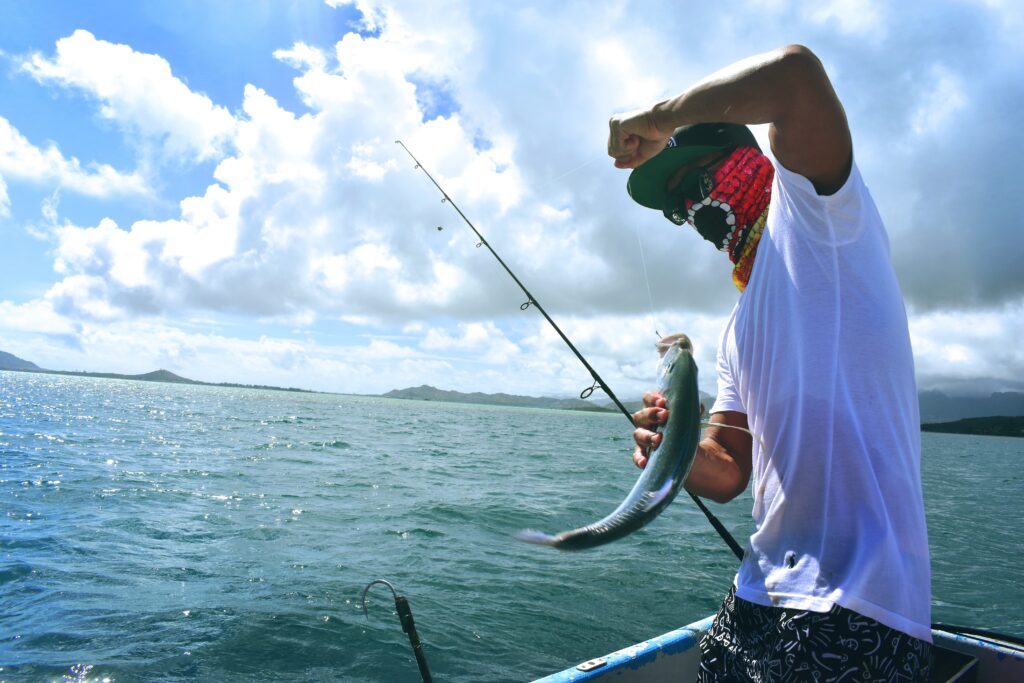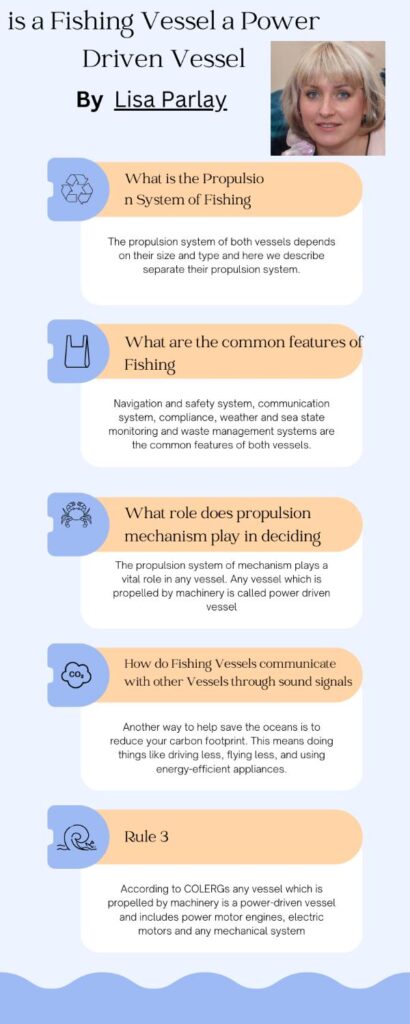First it is important to understand what specification & classification of fishing vessels and power driven vessels because their purpose, method, size and propulsion system can overlap but both have different qualities.is a Fishing Vessel a Power Driven Vessel.
Now many modern fishing vessels are equipped with power motor engines and both vessel types follow different rules and regulations for their propulsion process including their speed, area & navigation system are different in certain situations.
Fishing vessels are commonly used in commercial fishing, fishery research and many fishing operations. Fishing boats, trawlers, longliners, purse seiners and gillnetters are types of fishing vessels
Power-Driven vessels are used in commercial shipping, transportation, military & security and many recreational activities. Below we understand this in detail.
jump to a specific section
- 1 What is the Propulsion System of Fishing and is a Fishing Vessel a Power Driven Vessel?
- 2 What are the common features of Fishing and Power-Driven Vessels?
- 3 How does COLREGs classify a vessel as Power-Driven or What is Rule 3?
- 4 What are the common causes of collisions between Fishing and Power-Driven Vessels?
- 5 Final Verdict
What is the Propulsion System of Fishing and is a Fishing Vessel a Power Driven Vessel?
The propulsion system of both vessels depends on their size and type and here we describe separate their propulsion system.
Propulsion System of Fishing Vessels: Fishing vessels works with Single Screw Propeller, Twin Screw Propeller, Outboard & Inboard Motors and Jet Drives. Single & Twin-Screw Propeller use in diesel engine for better efficiency and control and each Screw Propeller connected to different engine.
Outboard and Inboard Motors are used on shoreside and coastal surface and while the Jet Drives use in need of speed in risk of damage or danger situations.

Propulsion System of Power-Driven Vessels: Their propulsion system works with Gas Turbine Engines, Pod Drives, Electric Propulsion, Big Diesel Engines, Waterjet Propulsion, Hybrid Propulsion, Azimuth Thrusters and Nuclear Propulsion.
Diesel Engine and Hybrid Propulsion are used for better efficiency and consumption of fuel. Azimuth Thrusters & Pod Drives are used for rotation and even modern ships can rotate at 360 degrees. And Nuclear Propulsion is used in Military Submarines and planes.
What are the common features of Fishing and Power-Driven Vessels?
Navigation and safety system, communication system, compliance, weather and sea state monitoring and waste management systems are the common features of both vessels.

In navigation system both vessels have GPS, Radar, sound charts, navigation lights and depth sounders to safety process in ocean. In the communication system both vessels use VHF (Very High Frequency) radios and satellite communication.is a Fishing Vessel a Power Driven Vessel
What role does propulsion mechanism play in deciding whether a Fishing Vessel is Power-Driven?
The propulsion system of mechanism plays a vital role in any vessel. Any vessel which is propelled by machinery is called power driven vessel. Machinery Propulsion, Safe and Power Combination and Exclusion & Unmanned vessels are keys of mechanism that define it is fishing vessel or power driven vessel.
How does COLREGs classify a vessel as Power-Driven or What is Rule 3?
International rules and regulation COLERGs supply guidelines for vessels that make safe and secure to prevent collisions in Maritime traffic. COLERGs supply the definition of Rule 3 whether it is fishing vessel or power-driven vessel. Here is the definition of Rule 3.
Rule 3
According to COLERGs any vessel which is propelled by machinery is a power-driven vessel and includes power motor engines, electric motors and any mechanical system of propulsion is Rule 3 (a). And in Rule 3, Rule 3 (b) is any vessel which is under sailing provided by machinery and if fitted is not used.
Are there circumstances where a fishing vessel may change its classification from Power-Driven to non-Power-Driven during its operations?
Yes, in certain situations a fishing vessel is classified as a power-driven vessel in maritime operations but follows the rules and regulations of Maritime Law.
Her are some conditions when sailing while fishing in need of fuel consumption they convert in hybrid engines and Drifting and Fishing Gear operation when engine is off, they want to navigate in certain conditions.
What is Deference of Avoiding collision between Fishing vessels and Power-driven vessels?
Even now that various navigation instruments have been developed, collision accidents between fishing vessels and general power-driven vessels at sea occur repeatedly.
According to the Transportation Safety Committee “Fune to Umi,” (Marine Accident Inquiry Safety Investigation Association) at the end of July 2016, there were 491 cases of ship accidents in Japan in 2016.

Fishing vessels accounted for 163 of these cases, approximately 33% of the total accidents. This study, we have carried out a questionnaire addressing three points: (1) Fishing vessels’ awareness of other vessels, (2) Determining if fishing vessels were power-driven when they were not engaged in fishing, (3)
/
The distance fishing vessels crews keep avoiding other vessels.
The results were as follows: (1) The difference in awareness between light time and dark time, a state in which look out conditions are poor (over half), (2)
Approximately 20% of respondents recognized “fishing vessels” = (equal) “vessel engaged in fishing,” (3) Although it depends on the age of the fishermen and how experienced they are, approaching another ship up to 500 m, they think about avoidance actions, and it was found that there was a high possibility of some action to be performed.
What are the common causes of collisions between Fishing and Power-Driven Vessels?
Collision happened between fishing vessels and power-driven vessels due to many factors. Limited and poor visibility, lack of awareness about maritime traffic,
Error in navigation system and crowded areas, Communication signal problems, equipment failure, speed differences and Weather conditions are the common factor of collisions. And not following the international regulations (IMO) & COLERGs is also a factor of collision between fishing vessel and power-driven vessel.
Here’s the information presented in a table format without indicating it’s AI-generated:
| Topic | Details |
|---|---|
| Significance in Maritime Law and Regulations | – Classification as a power-driven vessel subjects the fishing vessel to specific maritime laws and regulations. |
| – Determines the application of international conventions like the COLREGs (International Regulations for Preventing Collisions at Sea). | |
| – Affects requirements for onboard equipment, crew qualifications, and operational standards. | |
| Safety Protocols | – Power-driven vessels must adhere to stricter safety protocols, including navigation lights, sound signals, and communication equipment. |
| – Impacts the vessel’s responsibility in maintaining safe speeds, lookout practices, and ensuring the safety of other vessels and crew. | |
| Impact on Navigation Rules | – Power-driven classification affects the vessel’s role in navigation rules, including right-of-way priorities and actions to avoid collisions. |
| – In situations where a power-driven vessel encounters non-powered vessels (e.g., sailboats), the power-driven vessel often bears greater responsibility for avoiding collisions. | |
| Right-of-Way and Collision Avoidance | – Power-driven vessels have specific obligations to give way or stand on, depending on the situation and type of other vessels encountered. |
| – Classification can influence liability in collision incidents, as power-driven vessels are generally expected to maneuver more effectively. | |
| Conclusion | – Proper classification ensures compliance with laws, enhances safety, and reduces the risk of accidents. |
| – Understanding the implications of this classification is crucial for all mariners. |
How do Fishing Vessels communicate with other Vessels through sound signals?
Both vessels communicate for security and safety to reach their destination and they communicate through a sound system and radio satellite system. And in certain conditions like if the weather condition is not proper, they can show through their light navigation system.
If a power-driven vessel overtaking any vessel, they did not sound break or any signal it beans a collision happened and we already discuss about collision factors.
What Regulations and Rules Implement on Both Vessels and Are the same Laws Implement on both Fishing and Power-Driven Vessels?
No, commonly there are different rules and regulations implement on both vessels because of their propulsion eligibility, range areas and their size matter in condition of what they use their vessel for what purpose like a fishing vessel has specific area and speed limit and
the power-driven vessel has different roots for transportation and different speed limit in certain conditions. Here are some Rules Accordingly COLERGs
Rule 2: to keep proper lookout and safe speed.
Rule 5: for proper lookout to sight and hearing prevent collision.
Rule 6: for safe speed and stop from collision damage.
Rule 7: for when vessels are close reduce speed and give- way.
Rule 12: for sailing vessels give way by both fishing and power-driven vessels.
Rule 14: for Head-on situations.
Rule 15: for crossing situation.
Rule 17: Action by stand-on vessel.
Rule 18: for Responsibilities between vessels.
Rule 19: Conduct of vessels in Restricted Visibility.
Rule 25: for sounding and light signals
Rule 36: for signals to attract attention
Remember: The important thing is that every county supports their national policy on this maritime traffic but also adopts international laws.
Final Verdict
So yes, a fishing vessel can be a power-driven vessel as classified by proper propelled mechanism and follow all the rules and regulations accordingly (IMO) international Maritime Organization and COLERGs. And we know that any vessel which is propelled by machinery is a power-driven vessel so we can say that a fishing vessel can be a power-driven vessel.